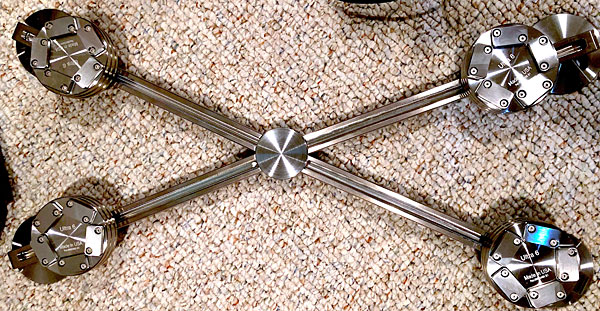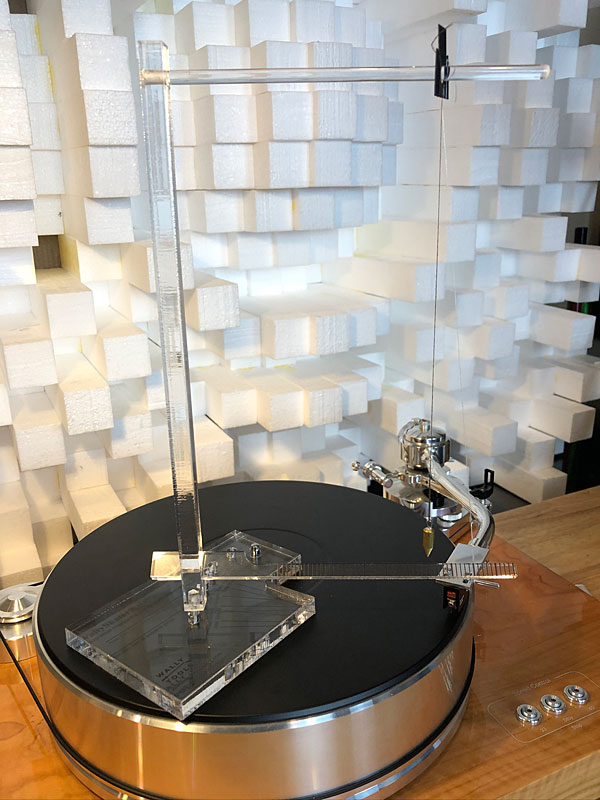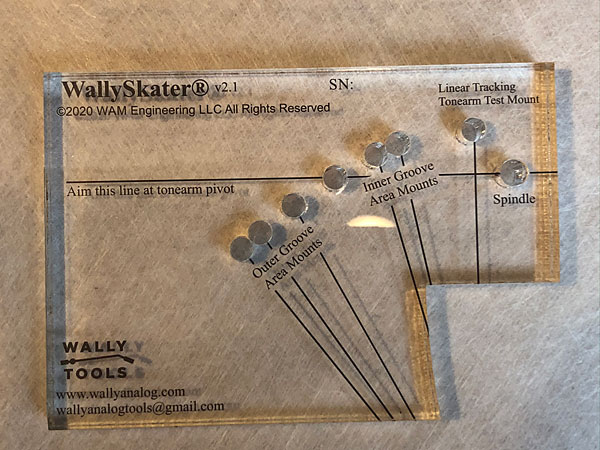| Columns Retired Columns & Blogs |
... Dave Mason isn't worn out, either.
https://www.youtube.com/watch?v=Xd56ap_aa4k
The Gaia-Titan Cronos includes thread adaptors for sizes ½"-13, M10-1.5, and M14-2.0. If that's not what your speakers use, the company can supply what's needed.
Total coincidence: When I went to the Marten Audio website to get some information for the Oscar Duo review, I noticed that Marten has contracted with IsoAcoustics to supply Marten-cobranded footers.
The Most Elegant Record Brush Ever?
I didn't think anything could top the Levin Design wood-and-aluminum–handled goat hair record cleaning brush (see en.levindesign.de/products), but the ramar brush (footnote 2), which is hand-made in Berlin, is by far the most aesthetically pleasing yet. It is also uniquely constructed, starting with eight double rows of brushes that include both carbon fiber and goat hair.

The ramar brush, which is handmade to order, is available in three wood finishes: "Tina," "Red," and "Joni." Tina features a matte-brown– to-black finish, Red has an appropriately reddish-warm color (Rodney? Callender? Nichols? Skelton? Buttons? Auerbach?), and Joni is, you guessed it, light-grained and blond-ish; as the website says, it's "stardust."
These handmade brushes make you want to brush even the cleanest of records. The brush handle magnetically locks into the base, which inside also magnetically holds a stiff-bristled stylus cleaning brush of satiny-brushed stainless steel in which a razor-thin wooden insert is embedded.

For the man or woman who has spent tens of thousands or hundreds of thousands of dollars on an analog front end, what's another $330 or so dollars for the most luxurious, esthetically pleasing, silky-to-the-touch record brush that, by the way, also removes dust effectively.

A more plebian (though still attractive) double–seven-row brush, this one manufactured in China and distributed by Ursa Major (footnote 3)—also a German company—is all carbon fiber. It's available fitted with a variety of wooden inserts—six in all—for $52, all of which were out of stock when I last checked the website.

Another useful, versatile, and most cost-effective brush is from Stasis Corporation (footnote 4). This no-nonsense brush is manufactured in Malaysia and distributed in America by Musical Surroundings. The Stasis brush is ivory, the Record Doctor "Clean Sweep" brush is ebony; otherwise, the two brushes appear to be identical, including the thickness (50 micron) and number (260,000) of chemically inert nylon bristles. Either can be used for dry cleaning or to apply liquid, but I would buy two instead of using the same one both ways. The Stasis brush is available at Audio Advisor for $24.95—as is the Clean Sweep brush, for $5 less.
And then there's my "daily driver" record brush, the AudioQuest Conductive LP Cleaning Brush, still widely available for $29.95.
I'm sure you've noticed that vinyl records are not pressed in clean rooms. Straight out of the jacket, most are dusty and should never be played without at least a good dry brush wipe. Better yet, wet clean on a vacuum or ultrasonic-cavitation machine.


The photos above show two new, just-out-of-the-sleeve albums before and after quick-dry brushings—one with the Stasis brush, the other with the ramar brush. Both albums were well-pressed at Pallas in Diepholz, Germany. The first, which I swept using the Stasis brush, is Dion's excellent new blues album, Blues With Friends (KTBA Records 61081). The second, brushed by the ramar brush, is Norah Jones's audacious Pick Me Up Off the Floor (Blue Note B003179801).
The Stasis did a decent job, as you can see, but the ramar easily won this dust-off.
The Tonar Tacky Cleaner
The "In the Groove" tacky roller, which I recommended for platter cleaning (though it was intended mainly for cleaning records), is no longer available, but a very similar device—the Tonar "Tacky Cleaner"—is imported and sold on the StylusTimer website (footnote 5). It's a handheld, washable roller designed to be rolled straight across a record surface to pick up dust on the surface of and within the grooves. I can easily recommend it for hard-platter surface cleaning (obviously not for use on felt or cork mats since you don't want to lose chunks), especially if your platter has vacuum hold-down.

I'm less sanguine about applying anything sticky to a record's surface, although the manufacturer insists it leaves no residue. I feel the same about Pro-Ject's "Vinyl Clean," a Gatorade-green, malleable ball of goo you roll and press into a record surface; it, too, is claimed to not leave a residue, but it's not washable and has an 8-month use cycle.
StylusTimer sells the Tacky Cleaner for $37.95 and offers it bundled with the $19.95 StylusTimer for $54.95, with two StylusTimers for $72.95, or with a five-pack of StylusTimers for $114.95.
Stillpoints Component Stand SS
These adjustable, space-saving stands (footnote 6) can be spread out or narrowed as needed and locked securely in that position, to accommodate the bottoms or footers of amplifiers of various sizes. The stand itself, which I am told is available in various sizes and configurations, ranging in price from $1999 to $2799, sits on wide, flat aluminum feet that will stabilize the load resting on the cross bars. Even the heaviest amplifiers can be accommodated.

Getting heat-producing amplifiers off carpeting is a good idea if only for safety's sake—never mind reducing the sonic effects of both airborne and structure-borne vibrations and vibrations generated by the amplifier itself. Some people don't believe that microvibrations affect component values on circuit boards; they do, say people I trust. If the gear uses vacuum tubes, there's no question about the sonic effects of damping, draining, or isolating vibrational energy.
The advantage of an adjustable-width amp stand that takes up less floor space than the amp itself is obvious, especially if space is tight. The stands I used cost $2495 each—so not for the budget-minded. A worthwhile option is to add Stillpoints footers, which dissipate vibrational energy by turning it into heat, and placing the amps on the footers, which, once locked into the stand's grooves, can slide as needed to accommodate the amplifier's feet or its bottom surface. Stillpoints recommends the new, $349 Ultra 2s, which would total $7782 for two of these stands. My samples, though, were equipped with Ultra 6 footers, which cost $899 each.
When, last year, I swapped out the wooden Finite Elemente amp stands under my reference darTZeel NHB-468 monoblocks, whose cross-braced frame is fitted with strategically placed cylinders that purposely vibrate like tuning forks, in favor of the Stillpoints stands, I can't say the darTZeel amps sounded noticeably different, but I've heard from friends using them under tube amps who say they definitely work.
Audible difference or not, in my space-limited room, the Stillpoints amplifier stands made my reviewing life much more convenient. I still have the VAC 452 iQ amps I reviewed, stuck here (poor me) because of COVID-19. Those big, heavy amps are sitting on the Finite Elemente stands, so that real-time "A/B" listening test is not going to happen!
The New Wallyskater 2.1 Antiskating Gauge
I've covered this product at Analog Planet already, but in order for a product to be eligible for Recommended Components inclusion, it must be covered in Stereophile, so here goes.

The new WallySkater is a much-improved version of the original, which was designed by my late friend and mentor Wally Malewicz. Wally told me that one cause of skating was the tonearm's offset angle. Groove friction produces a drag force directly behind the cantilever, but because of the offset angle, the pivot is not directly in line with the drag, so the energy goes elsewhere and that produces the "skating" action, forcing the stylus inward toward the label.
Only that's not really true, as you'll see if you watch the videos on AnalogPlanet under the click-bait headline, "Everything You Know About Skating Is Wrong!".

Some readers were offended that I would sully my late friend Wally's reputation, but Wally's son Andrzej and J.R. Boisclair did the research. Mr. Boisclair thinks Wally probably knew what he was claiming was incorrect, but it made skating simpler and easier to grasp. In any case, the new WallySkater is a far more sophisticated and finished product than the original. In place of the original's "Sharpie" markings, the horizontal bar on the new one is embossed—or however plastic rulers get those raised markings. The new, thicker, embossed base plate features holes for the vertical tower calibrated for 9", 10.5", and 12" effective-length arms, and there are now two sets of holes, one for the outer groove area and one for close-to-the-spindle calibration.

For reasons explained in the videos, the design of the antiskating system should lower the antiskating force as the arm gets closer to the record label. This new WallySkater lets you both set antiskating more accurately and also check the efficacy of the antiskating system your arm uses.
The WallySkater costs $260 and is available direct from the WAM Engineering website (footnote 7). While not every audiophile needs to invest $260 in such a device, I believe that every audio club and society should get one and loan it out to members. For reviewing, it's an essential tool.
In addition to the new WallySkater and new WallyTractor, WAM Engineering plans to soon introduce new setup tools and produce new informative videos.
Footnote 3: Ursa Major. Web: ursa-major.eu/shop-us.
Footnote 4: Stasis Corporation. Web: stasisonline.com. US distributor: Musical Surroundings, 5662 Shattuck Ave. Oakland, CA 94609. Web: musicalsurroundings.com.
Footnote 5: Tonar Tacky Cleaner. StylusTimer. Web: stylustimer.com/tacky-cleaner.
Footnote 6: Stillpoints, 573 County Rd. A, Suite 103 Hudson, WI 54016. Web: stillpoints.us.
Footnote 7: WAM Engineering, LLC. Tel: (707) 210 6345 Web: wallyanalog.com/product-catalog.

... Dave Mason isn't worn out, either.
https://www.youtube.com/watch?v=Xd56ap_aa4k

Ha Ha! crazy audiophiles buying $3200 footers to improve the sound of their speakers. The question that should be asked to the speaker manufacturers as to why we have to spend MORE money to hear better sound from their speakers when we have already paid for it. Why are these footers or equivalent or their equivalent feature not in their speaker? Why were the speaker guys sleeping at their posts? They probably will say it is unnecessary. Same as buying $3000 speaker cables to get an audio signal from an amplifier to a speaker 4 ft away, boy those speakers but be poorly designed.

Using larger box British BBC monitors with high mass "anchor" stands spiked to concrete (through carpet), my situation is much different than floor standing speakers.
I have another variable to contend with- the isolation "dot" between stand and speaker. And man, do they make a difference ! I just completed a shootout with many different "dot" materials and sizes- sorbothane, hard silicone rubber, softer silicone rubber, cork, etc.
I would not mind isolating the stands but don't want it to ruin the "dot" synergy I have.

... various speaker/stand interface materials in this report:
https://www.stereophile.com/features/806/index.html

Hi
I've done both ways for my KEF 2-way stand speakers:-
(1) the BBC monitor way - spiked tripod on the wall-to-wall carpeted concrete basement floor of my audio den.
(2) isolation flat "dots" made of quarter-sized semi-hard silicon round pads between the tripod & the loudspeaker cabinet base.
The "dots" adds more body to the low-mid spectrum which was cleaned up by the tripod on spikes. Well balanced.
Jack L

Hi
What a bold claim !
First off, why Boisclair used a shiny glass disc for his demo & denounced grooveless disc should not be used for anti-skating test ? Don't tell me he does not know the surface friction of a smooth glass disc is next to nothing vs a grooveless test disc made of vinyl, same material used to stamp the music LPs since day one decades back.
So London FFSS produced & sold tons of test vinyl LPs (with grooveless tracks to anti-skating test) decades back did not know what it was doing???
I got one such London FFSS test record & have used the grooveless track there to test anti-skating of turntable/tone arm combos since day one decades back.
As per Boisclair, I have been doing the test "wrong" ! Being "wrong" because of not using the tractors Boisclair supplied.
Give me a break, please!
My expensive SME black fiberglass tone arm/moving coil cartridge, which I dismantled completely, repaired & reinstalled back on my direct-drive TT, now tracks the grooveless track of my London FFSS test record perfectly after its alignment using my simple tools. So I have done its anti-skating "wrong" because I did not use the tools supplied by Boisclair !!!!
So will Boisclair please school me how?
Jack L

... is made of black fiberglass?

Hi
Correction:
It should be London FFRR test record: "How to give yourself a stereo check out".
Jack L

For what it's worth, I tried these with Vandersteen Treo CTs a while back. When I emailed Vandersteen to ask how I should adjust the speakers to accommodate them (they use a system of washers on the rear center spike to aim the tweeters at the listener's ears), Richard called and gave me a long explanation of why he believes his speakers, at least, should be firmly anchored to the floor with the spikes and washers he provides, thus ensuring accurate phasing alignment. I sent the IsoAcoustics back and was more pleased with the result. Your mileage, etc.

"There's also a link on that page to an explanation of how this patented product works"
On what page? Tried the Isoacoustics site and did not spot the explanation of how they say these work. No idea what page is being referred to, either. Could you please make this simpler by supplying the link, TIA?

decoupling a mass from a floor essentially lowers the mass of the entire system ( raising the system's resonant frequency ).
It's audible, for better or worse.
The only thing I've noticed not making any noticeable change to system performance is Speaker Cable trusses.
Is there a Loudspeaker Manufacturer 'improving' their Loudspeaker offerings with this technology?, I'm not aware of any but I'd like to see one or even many report great things from a new floor suspension option.
Where is Wilson on all this?, where is Magnapan, Magico? where are the big Pro-Audio people ?
On the other hand, P&A ( parts & accessories ) are an important contributor to Retail Dealer Profits.
Better Shock absorbers improve ( or change ) performance.
For what it's worth, 3M make this sort of device bubble packed, Home Depot, Lowes and Hardwares Everywhere.
It might be fun to AB test a bunch of these devices ( especially if helped by a serving of enhanced Brownies ).
Tony in Venice

...... system performance is Speaker Cable trusses." quoted tonykaz
I've got ALL floor lying cables, ie: power cables (including 4 dedicated CONDITIONED power lines from my house main power panel to my audio rig), speaker cables, elevated 4" above the fully-carpeted concrete floor of my basement audio den, using small semi-rigid cellular foam blocks spacing 6" apart along the whole way.
Technically, it is a very sound measure:
(1) The foam block cable suspenders serve to absorb any vibrations due to close-by footdrops & loudspeaker soundwaves at high volumes.
(2) There are miles & miles of utility power cables concealed behind the walls, & underneath the floors of any house/building, forming a huge antenna loop to receive & re-transmit RFI/EMI noises which are made worse with WIFI.
Concrete floors are the worst RFI/EMI noise situation: the reinforcement steel bars buried inside the poured concrete form a powerful antenna for the unwanted RF noises.
So ALL floor lying UNSHIELDED cables must be elevated from the concrete floor surface to minimize the RF noises transmitted from the steel bars buried inside the concrete floor. So cable suspenders are a MUST !!!!
To ensure my bi-wired loudspeaker cables to immune from the RF noises, I
added an inline RFI/EMI nosie suppressor onto each of cables, 4 of them totally.
Listening is believing
Jack L

You reveal a complex system and understanding.
I simply state that I've never noticed any difference ! ( it could be that I've tuned it out )
Years ago I represented Monster Cable and carried thier entire Line of Cable accessories. Folks buy and like Trusses.
and
you probably are a more sensitive audiophile than me.
For me, music is an imperfect life companion that can Mood-alter if I ask to.
and
my shirt pocket Audiophile systems don't need trusses.
Tony in Venice

Hi
Bingo!
Jack L

...... of the entire system ( raising the system's resonant frequency ). quoted Tonykaz
Hi
Nope.
If the spikes are pointing DOWNWARDS in contact of the floor, the point contacts increase the object effective mass big big time, thus lowering its resonance frequency.
You will find it will clean up the overall audio spectrum of the sound distinctly, delivering much more details, transparency, & precision imaging. This improvement happened to mine.
As already posted above, I've also isolated my KEF 2-way loudspeaker cabinet from the spiked steel tripod stand with 4 silicon rubber pads. It enriches the mid-low spectrum of the music.
Listening is believing
Jack L

This is a place where I'd ask John Atkinson to measure Loudspeaker performance with these devices.
Jim Theil had some of his range of loudspeakers drilled out for 1/4" dowel spikes but refrained from endorsing their use. I've used and not used with pleasing results, I prefer no spikes or even casters.
I'm just not a tweaky, hair shirt Audiophile. I loved Meridian Active Loudspeakers enough to Import their entire Range.
If Stereophile is going to continue to endorse these Iso Feet Suspensions I'd like some measurements explaining what's happening. ( I can certainly live without it )
and
I wonder if they will make my Maytag Washer's Rinse cycle run any less bumpy-whobbly ?
Tony in Venice

Hi
Bingo!
Jack L